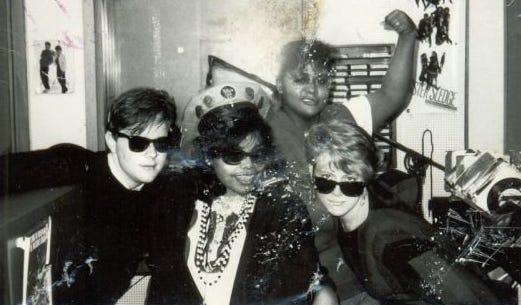Mark Rushton’s Interpolation in the Arts is a weekly email on Substack where I talk about my ongoing work as a recording artist and visual artist.
This email is brought to you by the Mark Rushton Gallery, for printed and original artworks. License my music, sound fx, and illustrations at Pond 5 for your creative project. I’m on Bandcamp and all the usual streaming services.
This week’s topics:
Internet 1.1
College Radio, Part One
College Radio, Part Two
College Radio, Part Three
What’s Next?
Kate Bush - “Hounds of Love (Live)”
Internet 1.1
This past week, I’ve been doing research on radio stations in the US and collecting information about them. Next week will be Canada, our 51st state (j/k, eh) and then the rest of the world.
Artists should try to be everywhere. I realized I had a gap in my process and that gap was radio.
Shrinking the world seemed like the promise of Internet 2.0/social media. But then the billionaires needed more money, so they throttled and censored and enshittified everything.
You really shouldn’t hang around a poisoned and corrupt environment, and so I abandoned social media. I rolled back to Internet 1.0 or maybe 1.1, which for me is basically a web site, email, and some other services that are not “social media”.
College Radio, Part One
Part of my research has involved college radio stations, so it was fun to see what the kids have been up to these days. Honestly, that world doesn’t look much different from when I left it in 1990. Considering what I saw, they have excellent musical taste across multiple genres and generations.
For me, college radio was a terrible experience. It’s a long, horrible story involving institutional corruption, and I’d like to forget it. It’s no wonder why I’m skeptical of everything.
I did meet my wife at the radio station, and that worked out well.
After leaving the university, I moved to another state, went to art school for a couple of years, and then found my career in tech.
College Radio, Part Two
In contrast, my high school radio experience, from 1982-1985, was a total dream. Like something out of a revisionist history 80s movie. I played all the cool British imports and US independent synth pop and post-punk sounds. I self-funded or borrowed records from people with incredible collections.
The station is still around, KDPS FM, in Des Moines, and I drive by it daily. I brought a lot of people into the studio, including kids from other schools and nearby towns who heard my shows and were inspired. Some of them started their own radio shows. It was a cultural touchstone for the community, as radio stations should be.
The evening station manager at KDPS, for a couple of years, was Dave Gruber Allen, who later went on to fame as the high school guidance counselor on the TV show Freaks & Geeks. Dave was the best.
College Radio, Part Three
Today, sending music submissions is much easier than 20, 30 or 40 years ago. Everything is computerized. Artists have metadata. Stations likely transmit their playlists to companies and services, and that’s OK.
Most terrestrial radio stations broadcast over the internet, so any station has the potential of a worldwide audience on services like TuneIn. A small number of college stations have given up their terrestrial FCC license involving transmitters and antennas and only stream.
As I expected, a lot of the college radio station web sites were a mess. Nothing new. Some were missing. Some were on Wix! My favorite web page was WKCO’s exec page (Kenyon College, Ohio). Do click through. It made my day. If the photos change in the future, here’s the archive of that beautiful page.
The best college radio stations used a generic email for the General Manager, Music Director, et al, but more than a few used an individual’s name, and that will be a problem for artists and record companies at the end of the school year.
Most allowed email submissions. Some, but not many, required that artists use a form. I will not send anything for consideration via a web form. That’s a hassle.
A small number of stations only wanted physical media to be mailed. Absolutely stupid today. We had these smelly mossbacks at the college radio station in 1989-1990. The enemy back then was the compact disc.
I like how so many of the kids today are into 80s and 90s bands and artists. Nostalgia burns me out a little, but it’s new to them. Typically, I’m more interested in What’s Next.
What’s Next?
I already pitch my new music to playlist curators, music libraries, and others.
Why not include radio stations? That’s something I got away from in the social media and streaming era. Are people going back to radio? Did they ever leave?
It does take a lot of research. I can’t send my music to every radio station that doesn’t play what I create. I do subscribe to a service that makes sending submissions fairly easy.
Most submissions probably don’t get read, much less heard. Even fewer get added. That’s OK. That’s part of the game.
It’s not about money or fame. It’s more about sharing. Contributing to society. The fun things we did when social media first showed up.
And part of me wants to see what I can get away with…
Kate Bush - “Hounds of Love (Live)”
I don’t know what’s good for me…




I'm so jealous you were a high school radio DJ! Sounds like a dream!
I was surprised at how much success I had with sending an 8-minute ambient drone track ("Palehound") to college and indie radio stations. However, it does take time to research, package, and send (and a little bit of cash for shipping materials and postage). If you only get played once, is it worth it? (Once is much more exciting than never!)